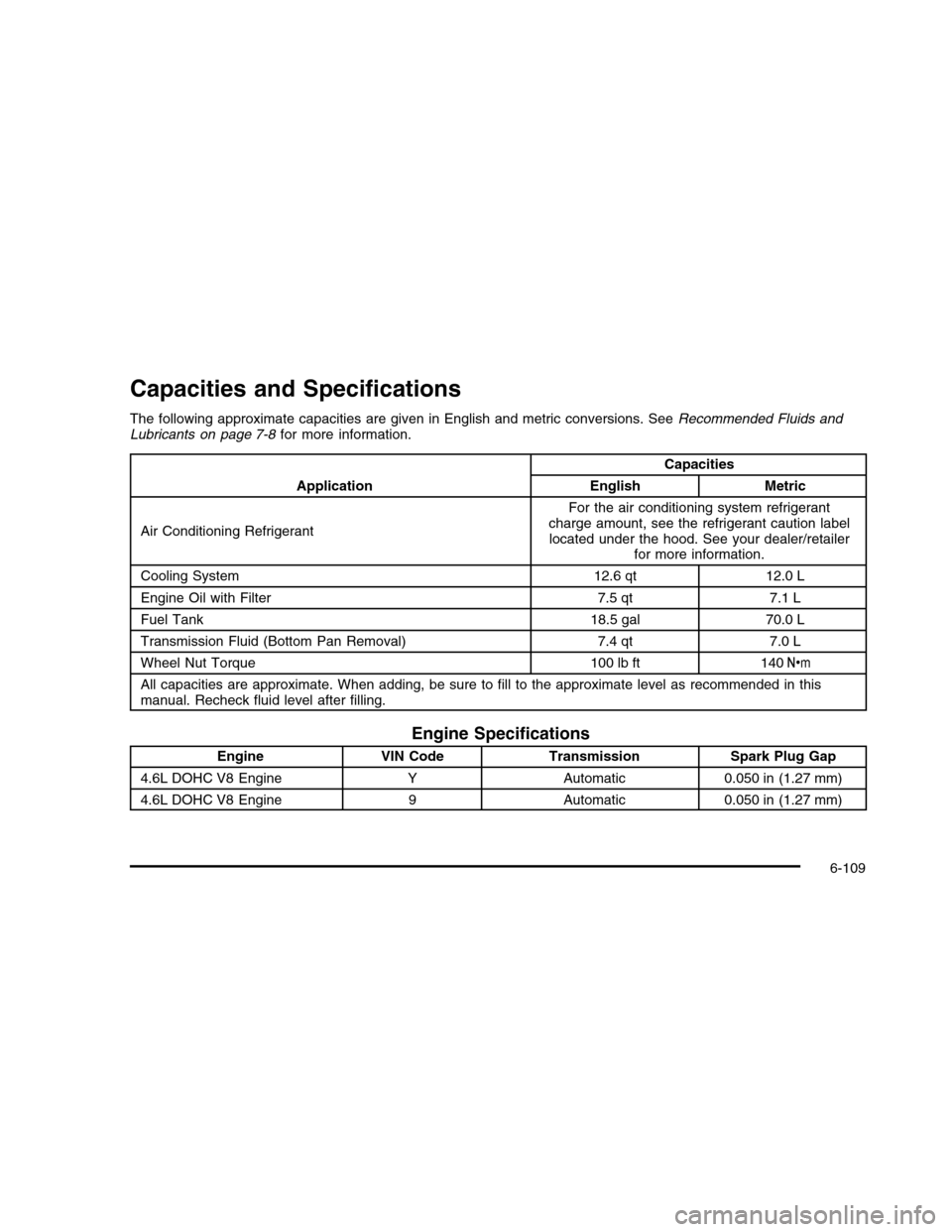engine CADILLAC DTS 2010 1.G Owners Manual
[x] Cancel search | Manufacturer: CADILLAC, Model Year: 2010, Model line: DTS, Model: CADILLAC DTS 2010 1.GPages: 480, PDF Size: 17.56 MB
Page 371 of 480

(F) Tire Ply Material:The type of cord andnumber of plies in the sidewall and underthe tread.
(G) Single Tire Maximum Load:Maximum loadthat can be carried and the maximum pressureneeded to support that load when used as asingle. For information on recommendedtire pressure seeInflation - Tire Pressure onpage 6-54.
Tire Size
The following illustration shows an example of atire size.
(A) P-Metric Tire:The United States version of ametric tire sizing system. The letter P as thefirst character in the tire size means a passengervehicle tire engineered to standards set by theU. S. Tire and Rim Association.
(B) Tire Width:The three-digit number indicatesthe tire section width in millimeters from sidewallto sidewall.
(C) Aspect Ratio:A two-digit number thatindicates the tire height-to-width measurements.For example, if the tire size aspect ratio is60, as shown in item C of the illustration, it wouldmean that the tire’s sidewall is 60 percent ashigh as it is wide.
(D) Construction Code:A letter code is used toindicate the type of ply construction in the tire.The letter R means radial ply construction;the letter D means diagonal or bias plyconstruction; and the letter B means belted-biasply construction.
(E) Rim Diameter:Diameter of the wheel ininches.
(F) Service Description:These charactersrepresent the load index and speed rating of thetire. The load index represents the load carrycapacity a tire is certified to carry. The speedrating is the maximum speed a tire is certified tocarry a load.
6-51
Page 381 of 480

The TPMS sensor matching process is outlined below:
1. Set the parking brake.
2. Turn the ignition switch to ON/RUN with theengine off.
3. Press the Remote Keyless Entry (RKE) transmitter’slock and unlock buttons at the same time forapproximately five seconds. The horn sounds twiceto signal the receiver is in relearn mode andTIRE LEARNING ACTIVE message displays on theDIC screen.
4. Start with the driver side front tire.
5. Remove the valve cap from the valve cap stem.Activate the TPMS sensor by increasing ordecreasing the tire’s air pressure for five seconds,or until a horn chirp sounds. The horn chirp,which may take up to 30 seconds to sound,confirms that the sensor identification code hasbeen matched to this tire and wheel position.
6. Proceed to the passenger side front tire, and repeatthe procedure in Step 5.
7. Proceed to the passenger side rear tire, and repeatthe procedure in Step 5.
8. Proceed to the driver side rear tire, and repeat theprocedure in Step 5. The horn sounds two times toindicate the sensor identification code has beenmatched to the driver side rear tire, and theTPMS sensor matching process is no longer active.The TIRE LEARNING ACTIVE message on theDIC display screen goes off.
9. Turn the ignition switch to LOCK/OFF.
10. Set all four tires to the recommended air pressurelevel as indicated on the Tire and LoadingInformation label.
11. Put the valve caps back on the valve stems.
6-61
Page 391 of 480

{WARNING:
Lifting a vehicle and getting under it to do
maintenance or repairs is dangerous without the
appropriate safety equipment and training. If a jack
is provided with the vehicle, it is designed only for
changing a flat tire. If it is used for anything else,
you or others could be badly injured or killed if the
vehicle slips off the jack. If a jack is provided with
the vehicle, only use it for changing a flat tire.
This vehicle may come with a jack and spare tire or atire sealant and compressor kit. To use the jack andspare tire, follow the instructions below. To use the tiresealant and compressor kit, seeTire Sealant andCompressor Kit on page 6-71.
Tire Sealant and Compressor Kit
{WARNING:
Idling a vehicle in an enclosed area with poor
ventilation is dangerous. Engine exhaust may
enter the vehicle. Engine exhaust contains Carbon
Monoxide (CO) which cannot be seen or smelled.
It can cause unconsciousness and even death.
Never run the engine in an enclosed area that has
no fresh air ventilation. For more information, see
Engine Exhaust on page 3-34.
{WARNING:
Over-inflating a tire could cause the tire to rupture
and you or others could be injured. Be sure to
read and follow the tire sealant and compressor kit
instructions and inflate the tire to its recommended
pressure. Do not exceed the recommended
pressure.
6-71
Page 400 of 480

Changing a Flat Tire
If a tire goes flat, avoid further tire and wheel damageby driving slowly to a level place. Turn on the hazardwarning flashers. SeeHazard Warning Flasherson page 4-3.
{WARNING:
Changing a tire can be dangerous. The vehicle
can slip off the jack and roll over or fall on you or
other people. You and they could be badly injured
or even killed.
WARNING: (Continued)
WARNING: (Continued)
Find a level place to change your tire. To help
prevent the vehicle from moving:
1. Set the parking brake firmly.
2. Put the shift lever in P (Park).
3. Turn off the engine and do not restart while
the vehicle is raised.
4. Do not allow passengers to remain in
the vehicle.
To be even more certain the vehicle will not move,
you should put blocks at the front and rear of the
tire farthest away from the one being changed.
That would be the tire, on the other side, at the
opposite end of the vehicle.
When the vehicle has a flat tire (B), use the followingexample as a guide to assist you in the placementof wheel blocks (A).
6-80
Page 419 of 480

Chemical Paint Spotting
Some weather and atmospheric conditions can create achemical fallout. Airborne pollutants can fall upon andattack painted surfaces on the vehicle. This damage cantake two forms: blotchy, ring-shaped discolorations,and small, irregular dark spots etched into thepaint surface.
Although no defect in the paint job causes this, we willrepair, at no charge to the owner, the surfaces ofnew vehicles damaged by this fallout condition within12 months or 12,000 miles (20 000 km) of purchase,whichever occurs first.
Vehicle Identification
Vehicle Identification Number (VIN)
This legal identifier is in the front corner of theinstrument panel, on the driver side. It can be seenthrough the windshield from outside. The VIN alsoappears on the Vehicle Certification and Service Partslabels and certificates of title and registration.
Engine Identification
The eighth character in the VIN is the engine code.This code identifies the vehicle’s engine, specifications,and replacement parts. See “Engine Specifications”underCapacities and Specifications on page 6-109forthe vehicle’s engine code.
6-99
Page 421 of 480

Power Windows and Other Power
Options
Circuit breakers in the fuse block protect the powerwindows and other power accessories. When the currentload is too heavy, the circuit breaker opens andcloses, protecting the circuit until the problem is fixed orgoes away.
Fuses and Circuit Breakers
The wiring circuits in the vehicle are protected fromshort circuits by a combination of fuses and circuitbreakers. This greatly reduces the chance of firescaused by electrical problems.
Look at the silver-colored band inside the fuse. If theband is broken or melted, replace the fuse. Be sure youreplace a bad fuse with a new one of the identicalsize and rating.
If you ever have a problem on the road and don’t havea spare fuse, you can borrow one that has the sameamperage. Just pick some feature of the vehicle that youcan get along without — like the radio or cigarettelighter — and use its fuse, if it is the correct amperage.Replace it as soon as you can.
Underhood Fuse Block
The underhood fuse block is located on the passengerside of the engine compartment. Remove the fusecover and secondary service cover to access thefuse block.
Notice:Spilling liquid on any electrical componentson the vehicle may damage it. Always keep thecovers on any electrical component.
6-101
Page 422 of 480

FusesUsage
1Engine Control Module (ECM), Crank
2Fuel Injectors Odd
3Fuel Injectors Even
4Air Conditioning Clutch
FusesUsage
5Air Injection Reactor (AIR) Solenoid
6Oxygen Sensor
7Emission Device
8Transmission, Ignition 1
6-102
Page 423 of 480

FusesUsage
9Engine Control Module (ECM),Powertrain Control Module (PCM)
10Climate Control System, InstrumentPanel Cluster Ignition 1
11Airbag System
12Horn
13Windshield Wiper
14Fog Lamps
15Right High-Beam Headlamp
16Left High-Beam Headlamp
17Left Low-Beam Headlamp
18Right Low-Beam Headlamp
19Windshield Washer Pump Motor
20Left Front Cornering Lamp
21Right Front Cornering Lamp
22Air Pump (J-Case)
23Antilock Brake System (ABS)(J-Case)
FusesUsage
24Starter (J-Case)
25Antilock Brake System (ABS)Motor (J-Case)
26Cooling Fan 2 (J-Case)
27Cooling Fan 1 (J-Case)
RelaysUsage
29Powertrain
30Starter
31Cooling Fan 2
32Cooling Fan 3
33Cooling Fan 1
34Air Conditioning Clutch
35Air Injection Reactor (AIR) Solenoid
36Ignition
37Air Pump
6-103
Page 426 of 480

FusesUsage
1Fuel Pump
2Left Park Lamp
3Run 3 - Rear Blower
4Right Park Lamp
FusesUsage
5Engine Control Module(ECM)/Transmission ControlModule (TCM)
6Memory Module
7Right Park Lamp (optional)
6-106
Page 429 of 480

Capacities and Specifications
The following approximate capacities are given in English and metric conversions. SeeRecommended Fluids andLubricants on page 7-8for more information.
Application
Capacities
EnglishMetric
Air Conditioning Refrigerant
For the air conditioning system refrigerantcharge amount, see the refrigerant caution labellocated under the hood. See your dealer/retailerfor more information.
Cooling System12.6 qt12.0 L
Engine Oil with Filter7.5 qt7.1 L
Fuel Tank18.5 gal70.0 L
Transmission Fluid (Bottom Pan Removal)7.4 qt7.0 L
Wheel Nut Torque100 lb ft140Y
All capacities are approximate. When adding, be sure to fill to the approximate level as recommended in thismanual. Recheck fluid level after filling.
Engine Specifications
EngineVIN CodeTransmissionSpark Plug Gap
4.6L DOHC V8 EngineYAutomatic0.050 in (1.27 mm)
4.6L DOHC V8 Engine9Automatic0.050 in (1.27 mm)
6-109